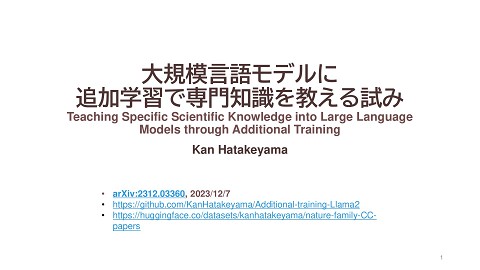Data-driven Optimal Pole Placement via Sylvester Equations
>100 Views
November 08, 25
スライド概要
20251108
SSS25
Assistant Professor, Graduate School of Informatics, Kyoto University
関連スライド
各ページのテキスト
Data-driven Optimal Pole Placement via Sylvester Equations Ikumi Banno, Kaiya Irie, Shun-ichi Azuma (Kyoto University) The 57th ISCIE International Symposium on Stochastic Systems Theory and Its Applications (SSS25); 2025/11/8 1A1-4
Motivation: “Robustness” for Pole Placement Pole Placement • Consider the system 1 −8 −5 1 0 𝑥ሶ 𝑡 = −2 −7 2 𝑢 𝑡 1 𝑥 𝑡 + −1 2 −9 0 1 −3 =𝑨 =𝑩 • Find a feedback gain 𝐹 ∈ 𝐑2×3 such that the eigenvalues of 𝑨 + 𝑩𝑭 are {−𝟏 ± 𝟐𝒊, −𝟑} • A solution is not unique, e.g., 𝑭𝟏 = −0.417 2.966 −0.750 −0.546 2.486 −0.616 𝑭𝟐 = −1.257 0.220 0.510 −0.935 1.280 −0.046 • Which gain should we use? “Robustness” for Feedback Gain • Consider the closed-loop pole sensitivity • Eigenvalues of 𝑨 + 𝑩𝑭𝟏 + 𝜟𝒊 is sensitive wrt 𝛥𝑖 - 𝛥𝑖 ∈ 𝐑3×3 : Random perturbation matrix • This is a motivation for robust pole placement 𝑨 + 𝑩𝑭𝟏 + 𝚫𝐢 (Sensitive) 𝑨 + 𝑩𝑭𝟐 + 𝚫𝐢 (Robust) 1
Contents 1. Introduction: Pole Placement 2. Problem Setting: Data-driven Robust Pole Placement 3. Proposed Method 1. Reduction to Sylvester Equations 2. Data-driven Method for Solving Sylvester Equation 4. Numerical Example 5. Conclusion 2
Introduction (1/2) Pole Placement • Computing a feedback gain that assigns the closed-loop poles to prescribed locations. - Such feedback gain is not unique in general How do we choose a feedback gain? • Recently, optimizations under pole placement constraints have been investigated - Feedback gain norm [Keel 1985], [Varga 2000] … reducing control energy - Closed-loop pole sensitivity [Hu 2004], [Schmid 2014] … preserving pole location from perturbation • A Mathematical model of a system is required When System Model Is Unavailable? • A Data-driven approach is a possible solution 3
Introduction (2/2) Data-driven Optimal Pole Placement • Compute optimal feedback gain directly from measurement data of the open-loop system • Existing researches are summarized as follows: Feedback gain norm Type of Minimization Closed-loop pole sensitivity Framework Model-based Data-based [Keel 1985], [Varga 2000] [Celi 2023], [Irie, 2025] [Hu 2004], [Schmid 2014] (No literature) • No research for a data-driven method for minimizing closed-loop pole sensitivity Objective of Our Research Derive a data-driven method for minimizing closed-loop pole sensitivity subject to a pole placement constraint 4
Problem Setting (1/2) System and Optimal Pole Placement • Consider the system 𝑥ሶ 𝑡 = 𝐴𝑥 𝑡 + 𝐵𝑢(𝑡) - 𝑥 𝑡 ∈ 𝐑𝑛 : state; 𝑢 𝑡 ∈ 𝐑𝑚 : input Weighted sum of 𝐢 closed-loop pole sensitivity 𝐢𝐢 feedback gain norm • Optimal pole placement [Varga 2000] is described as: Find 𝑭, 𝑽 ∈ 𝐑𝑚×𝑛 × 𝐑𝑛×𝑛 that minimizes 𝐽 𝐹, 𝑉 ≔ 𝛼 𝑽 𝟐 𝐅 + −𝟏 𝟐 𝑽 𝐅 + 1−𝛼 subject to the pole placement constraint 𝑭 𝟐𝐅 𝑽−𝟏 𝐴 + 𝐵𝑭 𝑽 = diag 𝜆1 , … , 𝜆𝑛 - 𝐢 corresponds to an upper bound of the closed-loop pole sensitivity, i.e., sup 𝜆𝑖 𝐴 + 𝐵𝐹 + Δ − 𝜆𝑖 𝐴 + 𝐵𝐹 𝑖,Δ Δ 2 5
Problem Setting (2/2) • Our interest is: when the system dynamics is unknown System Assumptions • For the system 𝑥ሶ 𝑡 = 𝐴𝑥 𝑡 + 𝐵𝑢(𝑡), we assume that: - 𝐴 is unknown; 𝑥(𝑡) - The dataset 𝓓 is available for pole placement 𝑡 𝒟: 𝒙 𝒕, 𝒙𝟎 𝒕 ∈ 𝟎, 𝒕𝐟 - 𝑥 𝑡, 𝑥0 : the state trajectory of the system with 𝑥 0 = 𝑥0 and 𝑢 𝑡 ≡ 0 Data-driven Problem for Optimal Pole Placement Given the dataset 𝓓, closed-loop pole location Λ ≔ diag 𝜆1 , … , 𝜆𝑛 Find 𝑭, 𝑽 that minimizes s.t. the pole placement constraint 𝐽 𝐹, 𝑉 ≔ 𝛼 𝟐 𝑽 𝟐𝐅 + 𝑽−𝟏 𝐅 + 1 − 𝛼 𝑽−𝟏 𝐴 + 𝐵𝑭 𝑽 = Λ 𝑭 𝟐𝐅 6
Convert to Unconstrained Optimization [Varga 2000] Original Problem (constrained optimization) Find s.t. 𝑭, 𝑽 that minimizes 𝐽 𝐹, 𝑉 ≔ 𝛼 𝟐 𝑽 𝟐𝐅 + 𝑽−𝟏 𝐅 + 1 − 𝛼 𝑭 𝟐𝐅 𝑽−𝟏 𝐴 + 𝐵𝑭 𝑽 = Λ Equivalent (under a reasonable assumption) Converted Problem (unconstrained optimization) Find The matrix 𝑮 that minimizes 𝑱 𝑮 ≔ 𝐽 𝐹 𝐺 , 𝑉 𝐺 • Gradient of 𝑱 is characterized by the solutions 𝑿, 𝒀 to the Sylvester equations Λ𝒀 − 𝒀𝐴 = −𝑄 𝐴𝑿 − 𝑿Λ = −𝑄 • The optimization is reduced to data-driven methods for solving these equations 7
Data-driven Solution to Sylvester Equation (1/2) • We aim to find a solution 𝒀 to the Sylvester equation Λ𝒀 − 𝒀𝐴 = −𝑄, 1 where - 𝐴 ∈ 𝐑𝑛×𝑛 is unknown - the state trajectory 𝑥 𝑡 of 𝑥ሶ 𝑡 = 𝐴𝑥(𝑡) 2 is available • Multiplying both sides of Sylvester equation (1) on the right by 𝑥 𝑡 : 𝛬𝒀 − 𝒀𝐴 𝑥 𝑡 = −𝑄𝑥(𝑡) 2 ⇔ 𝛬𝒀𝑥 𝑡 − 𝒀𝑥ሶ 𝑡 = −𝑄𝑥(𝑡) • By integrating the both sides on [𝑡1 , 𝑡2 ], we have 𝑡2 𝛬𝒀 න 𝑥 𝑡 𝑑𝑡 − 𝒀 𝑥 𝑡2 − 𝑥 𝑡1 𝑡1 𝑡2 = −𝑄 න 𝑥 𝑡 𝑑𝑡 𝑡1 - A linear equation with unknown matrix 𝒀 - Constructed by the dataset (without the matrix 𝐴) 8
Data-driven Solution to Sylvester Equation (2/2) • We can construct a linear equation from (a fragment of) 𝑥 𝑡 𝑡2 𝑡2 𝛬𝒀 න 𝑥 𝑡 𝑑𝑡 − 𝒀 𝑥 𝑡2 − 𝑥 𝑡1 = −𝑄 න 𝑥 𝑡 𝑑𝑡 𝑡1 3 𝑡1 • We obtain 𝑵 linear equations by dividing a dataset 𝒟 𝑥(𝑡) 𝑥(𝑡) 𝑡 The dataset 𝒟 #1 #2 ⋯ #𝑵 𝑡 Fragments of Trajectory Equation 3 for data #1 Equation 3 for data #2 ⋮ Equation 3 for data #𝑁 4 𝑁 linear equations Theorem: Data-driven Solution to Sylvester Equation If the dataset 𝒟 has sufficient information, 1) a solution 𝒀 to (4) is unique and 2) 𝒀 is equal to the unique solution to the Sylvester equation Λ𝒀 − 𝒀𝐴 = −𝑄 • Moreover, similar theorem holds for the other Sylvester equation 𝐴𝑿 − 𝑿Λ = −𝑄 9
Proposed Algorithm Algorithm: Data-driven Optimal Pole Placement Input: a dataset 𝒟, an initial matrix 𝐺0 Output: Feedback gain 𝐹∞ 1 For 𝒌 = 𝟎, 𝟏, 𝟐, … 2 𝑋𝑘 ← data-driven solution to Sylvester equation 𝐴𝑿 − 𝑿Λ = −𝐵𝐺𝑘 3 𝑌𝑘 ← data-driven solution to Sylvester equation Data-based Gradient Computation Λ𝒀 − 𝒀𝐴 = −𝑆(𝑋𝑘 ) 4 ∇𝐽መ𝑘 ← 𝑔(𝑋𝑘 , 𝑌𝑘 ) 5 𝐺𝑘+1 ← 𝐺𝑘 − 𝛾𝑘 ∇𝐽መ𝑘 6 𝐹𝑘+1 ← 𝐹 𝐺𝑘+1 7 end // gradient computation // update of parameter 𝐺𝑘 Update of Feedback Gain 𝑭𝒌 10
Numerical Example (1/2) System • Consider the system 1 −8 −5 1 0 𝑥ሶ 𝑡 = −2 −7 2 𝑢 𝑡 1 𝑥 𝑡 + −1 2 −9 0 1 −3 =𝑩 =𝑨 - Assume that 𝐴 is unknown, but the following dataset is available: Optimal Pole Placement Problem Find s.t. 𝑭, 𝑽 that minimizes 1 𝐽 𝐹, 𝑉 = 2 the pole placement constraint 𝟐 1 𝑽 𝟐𝐅 + 𝑽−𝟏 𝐅 + 2 𝑭 𝟐𝐅 −3 𝑽−𝟏 𝐴 + 𝐵𝑭 𝑽 = 0 0 0 −1 −2 0 2 −1 11
Numerical Example (2/2) Application of Proposed Method • Objective function value is monotonically decreasing • After the iteration, we finally obtain the feedback gain 𝐹53 = −1.257 0.220 0.510 −0.935 1.280 −0.046 - 𝐹53 satisfies pole placement constraint Verification for Closed-pole Sensitivity Reduction • We plot the eigenvalue locations of 𝐴 + 𝐵𝑭𝟎 + Δ𝑖 𝐴 + 𝐵𝑭𝟓𝟑 + Δ𝑖 optim. - Δ𝑖 𝑖 = 1,2, … , 1000 : random perturbation matrix • “Robust” feedback gain is obtained 12
Conclusion Summary • A data-driven robust pole placement is presented - Based on Data-driven solution to the Sylvester equation • The results can be extended to input-to-state data (in prep.) Future Work • Algorithm for noisy data • Robustness for structured perturbation Thank You for Your Attention! 13






